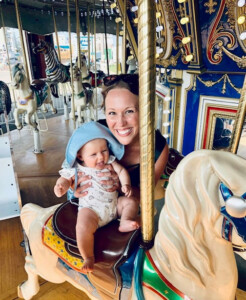Mealtime can be many things for a toddler: messy, routine, enjoyable, uninteresting, exciting, or, let’s face it, a total tossup. Especially if your growing tot would rather be elsewhere than at the table. That is, anywhere else but in their high chair. So what do you do when your toddler refuses to sit in their high chair?
It’s common for kiddos to refuse many things during the toddler years. Perhaps you cut their sandwich incorrectly, or they wanted the blue plate, not the white one. Some of our little people even have tantrums when it’s time to sit in their high chairs. However, breakfast, lunch, and dinner don’t have to become battlegrounds. Read on to discover why high chair refusal may happen in toddlerhood – and what you can do when your little one refuses to sit in their special seat at the table.1
Why a Toddler Refuses to Sit in Their High Chair
If your toddler refuses to sit in their high chair, it’s likely for one of many reasons, such as the following:
- They don’t like being confined to their high chair. Toddlers crave independence and freedom, and being strapped in a spot they can’t come and go from as they wish doesn’t allow for either. It’s essential that children can move freely and uninterrupted, and the high chair can sometimes get in the way of their desire to move their bodies and lead them to refuse to sit in it.2
- They are bored with mealtimes. Conversely, they might also be lacking structure surrounding mealtimes. Our little people can struggle when they feel frustrated and cannot express themselves; this can be when they feel bored, they aren’t yet ready to eat, or they feel unsafe or distressed because of a transition to eating or feeding when they weren’t prepared.1
- They want to be more like you. In other words, sitting in a “regular” chair. It’s normal for children to imitate the people around them and to want to replicate what they see, which can lead to toddlers refusing to sit in their high chairs.3
- Some children are not yet ready to sit unaided in a high chair. This could be due to musculoskeletal (muscles and bones) stress.4
What Can Be Done When a Toddler Refuses to Sit in Their High Chair?
Although the solution for when your toddler refuses to sit in their high chair will look different from one kiddo to the next, there are steps you can take to ensure your little one stays put long enough to get their daily nutrients in. If your toddler has been protesting the high chair, try the following tips to get back on track with ensuring safe, productive meals for everyone.
Go Back to the Basics
Double-check whether your child is appropriately restrained and comfortable in their high chair. Over time and as children grow, their high chair straps, and perhaps foot support, need to be adjusted, or your toddler might refuse to sit in their high chair. Children are less likely to sit tight and safely when adjustments aren’t maintained. For those without foot support, a generic detachable footrest can make a world of difference when it comes to child comfort and safety.5
Build Consistency
When young children know what to expect for the regular components of their day, they can get on board with habits more easily than if routines are ever-changing. Even if it seems your tiny human will only want to nibble away on the living room floor in front of their favorite cartoon (no judgment!), it’s never too late to set clear expectations for mealtimes – including seating arrangements – and maintain boundaries surrounding those expectations. Clear expectations and consistency can help avoid a toddler’s refusal to sit in their high chair.6
Lead by Example
If your toddler sees you frequently eating away from your seat at the dining room table – or simply getting up and down a lot throughout meals – they’ll likely be more aware of the temptation to ditch their spot, too, and refuse to sit in their high chair. On the other hand, if they see you consistently sitting down to eat in one dedicated area, they’ll realize there are family norms for mealtimes that everyone is expected to participate in.3
Have Your Kiddo Invest in Their Eating Space
Whether that means allowing them to pick out a fun new plate, cup, and utensil set or tasking them with the super important “job” of wiping down their tray before and after meals, allow your little one to take ownership of their high chair, instead of refusing to sit in it. Toddlers love feeling “in charge” of things. Capitalize on this as you work toward mending the high chair relationship.1
Support Developmentally Appropriate Feeding Experiences
In other words, let your little one be messy while in their high chair to avoid their refusal to sit in it. Doing so allows sensory and tactile needs to be met while providing a safe environment for exploring different tastes, textures, and foods. It only makes sense that the high chair is a more enjoyable place to be when this is the case.7
Be Intentional About Their Time in the High chair
Nobody likes to sit still too long, right? Toddlers have a lot of energy that can’t be contained for an extended time and this might lead to them refusing to sit in their high chairs. Help your little one out of the high chair as soon as they are done eating, and encourage movement-rich activities before each seating to keep the wiggles away long enough for them to fill up.2
Leave Room for Flexibility and Modifications
Some toddlers will never prefer being in a high chair, and that’s okay. They might want to try something more like what they see you or a sibling using, or they might desire a less restrictive space to focus more on eating and less on squirming. The goal is to find what works for you and your family. Learning towers, booster seats, kids’ tables and chairs, and even “big” (adult) chairs are all viable options when the high chair isn’t cutting it.
If you’re a parent to a toddler, you know how trying these years can be. Gaining cooperation during mealtimes is no exception. Although it is normal for a toddler to refuse to sit in their high chair, there are ways to make the family table more enjoyable for everyone.
































